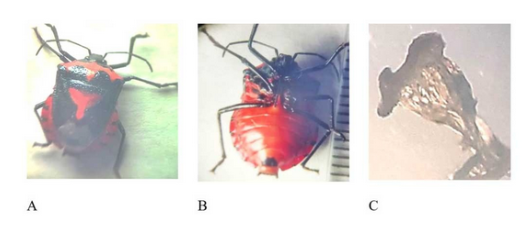New host of Vulsirea nigrorubra F. (Heteroptera: Pentatomidae) in Cuba
Main Article Content
Abstract
The objectives of this study were to identify the species of stink bug associated with Schoepfia Schreb (Olacacaeae) in a Protected Area and report Schoepfia schreberi (J.F.Gmel) as a host plant of Vulsirea nigrorubra F in Cuba. Samples of S. schreberi plants showing stink infection by stink bugs and damages by their bites were taken from the Varahicacos Natural Protected Landscape (23º,11' N; 81º,8'O), Varadero, Cárdenas municipality, Cuba, to the Entomology Laboratory at Matanzas University. The morphological diagnosis was carried out under a stereo microscope; adult males were processed to describe the parameres. Published works on Heteroptera and Keys of the family Pentatomidae Leach were used. The insects caused chlorosis in young branches, necrotic spot on leaves and forming fruits, as well as deformations on mature fruits. The numerous egg masses, nymphs and adults observed on plants indicated the stink bug reproduction on them. This work is the first report of a host plant for V. nigrorubra in Cuba and a new locality record for the insect.
Article Details

This work is licensed under a Creative Commons Attribution-NonCommercial 4.0 International License.
Aquellos autores/as que tengan publicaciones con esta revista, aceptan los términos siguientes:
- Los autores/as conservarán sus derechos de autor y garantizarán a la revista el derecho de primera publicación de su obra, el cual estará simultáneamente sujeto a la Licencia Creative Commons Attribution-NonCommercial 4.0 International (CC BY-NC 4.0) que permite a terceros compartir la obra, siempre que se indique su autor y la primera publicación en esta revista. Bajo esta licencia el autor será libre de:
- Compartir — copiar y redistribuir el material en cualquier medio o formato
- Adaptar — remezclar, transformar y crear a partir del material
- El licenciador no puede revocar estas libertades mientras cumpla con los términos de la licencia
Bajo las siguientes condiciones:
- Reconocimiento — Debe reconocer adecuadamente la autoría, proporcionar un enlace a la licencia e indicar si se han realizado cambios. Puede hacerlo de cualquier manera razonable, pero no de una manera que sugiera que tiene el apoyo del licenciador o lo recibe por el uso que hace.
- NoComercial — No puede utilizar el material para una finalidad comercial.
- No hay restricciones adicionales — No puede aplicar términos legales o medidas tecnológicas que legalmente restrinjan realizar aquello que la licencia permite.
- Los autores/as podrán adoptar otros acuerdos de licencia no exclusiva de distribución de la versión de la obra publicada (p. ej.: depositarla en un archivo telemático institucional o publicarla en un volumen monográfico) siempre que se indique la publicación inicial en esta revista.
- Se permite y recomienda a los autores/as difundir su obra a través de Internet (p. ej.: en archivos telemáticos institucionales o en su página web) antes y durante el proceso de envío, lo cual puede producir intercambios interesantes y aumentar las citas de la obra publicada. (Véase El efecto del acceso abierto).
References
Ruiz I, Hernández J, Ruiz E. Catálogo de las Áreas Protegidas de Cuba. En Ruiz I. (ed.). Las áreas protegidas de Cuba. La Habana, Cuba: Editorial Centro Nacional de Áreas Protegidas (CNAP). 2020. 386 pp. Web: www.snap.cu
González LR, Palmarola A, González L, Bécquer ER, Testé E, Barrios D. (Eds.). Lista roja de la flora de Cuba. Bissea. 2016; 10 (número especial 1): 1-352.
Kunakh M, Fedyay I. Are Heteroptera communities able to be bioindicators of urban environments? Biosystems Diversity. 2020; 28(2): 195-202. DOI: http://doi.org/10.15421/012025.
Dellape G. Actualización de la distribución de las chinches (Hemiptera: Pentatomidae) de Argentina. Rev. Soc. Entomol. Argent. 2021; 80 (1): 23-32. DOI: http://doi.org/10.25085/rsea.800103.
López M, Cervantes L. Life histories of Ramosiana insignis (Blanchard) and Vulsirea violacea (F.) (Hemiptera: Heteroptera: Pentatomidae), with descriptions of immature stages. Proceedings Entomological Society Washington. 2010; 112 (1): 81–96. DOI: http://doi.org/10.4289/0013-8797-112.1.81.
Grillo H. Los heterópteros de Cuba. [Tesis de Doctor en Ciencias]. 2012; Universidad Central “Marta Abreu” de Las Villas. Facultad de Ciencias Agropecuarias. Cuba. 397 pp.
Mancina CA, Cruz DD. Diversidad biológica de Cuba: métodos de inventario, monitoreo y colecciones biológicas. Editorial AMA (Ministerio de Ciencia, Tecnología y Medio Ambiente). La Habana, Cuba. 2017, 502 pp.
Betina N, Serrano A, Hidalgo M, Hernández M. Nuevos registros de localidades de heterópteros terrestres en el occidente de Cuba. Poeyana. 2020; (511): 45–52. Cu-ID: https://cu-id.com/2403/ojs340.
Kormilev N. Sobre los géneros Vulsirea Spinola (1837), Ramosiana Kormilev (1950) y Adoxoplatys Breddin (1903) con la descripción de tres especies nuevas (Hemipt. Pentat.). Rev. Soc. Entomol. Argent. 1951; 15: 83-95.
Pérez-Gelabert DE, Donald B. Stink bugs (Heteroptera: Pentatomidae) of the Island of Hispaniola, with seven new species from the Dominican Republic. Boletín Sociedad Entomológica Aragonesa. 2005; 1(37): 319−352.
Albano V, Bacca T, Gomes L. Anatomy of male and female reproductive organs of stink bugs pests (Pentatomidae: Heteroptera) from soybean and rice crops. Biota Neotrop. 2020; 20(4): 1-9. DOI: http://doi.org/10.1590/1676-0611-BN-2020-1045.
Castro V, Grazia J, Forero D, Fernández F, Schwertner CF. Stink bugs (Hemiptera: Heteroptera: Pentatomidae) of Colombia: An annotated checklist of species. Zootaxa. 2022; 5097(1): 001–088. DOI: http://doi.org/10.11646/zootaxa.5097.1.1.
Luccini AR, Panizzi MA, Silva MA, Marsaro AL. Performance and preference of Chinavia erythrocnemis (Berg) (Heteroptera: Pentatomidae) on reproductive structures of cultivated plants. Neotrop. Entomol. 2020; 49: 163-17.
BUGGUIDE. Vulsirea nigrorubra F (Pentatomidae) on Graytwing Tree. [Internet]. 2024 [citado 6 Febrero, 2024]. Available from: https://bugguide.net/node/view/732546/bgpage.
López M, Pérez P, Rojas JC, Soto RM, López L, and Rico V. Host use and resource sharing by fruit/seed-infesting insects on Schoepfia schreberi (Olacaceae). Environmental Entomology. 2013; 42: 231-239. DOI: http://dx.doi.org/10.1603/EN12284.
